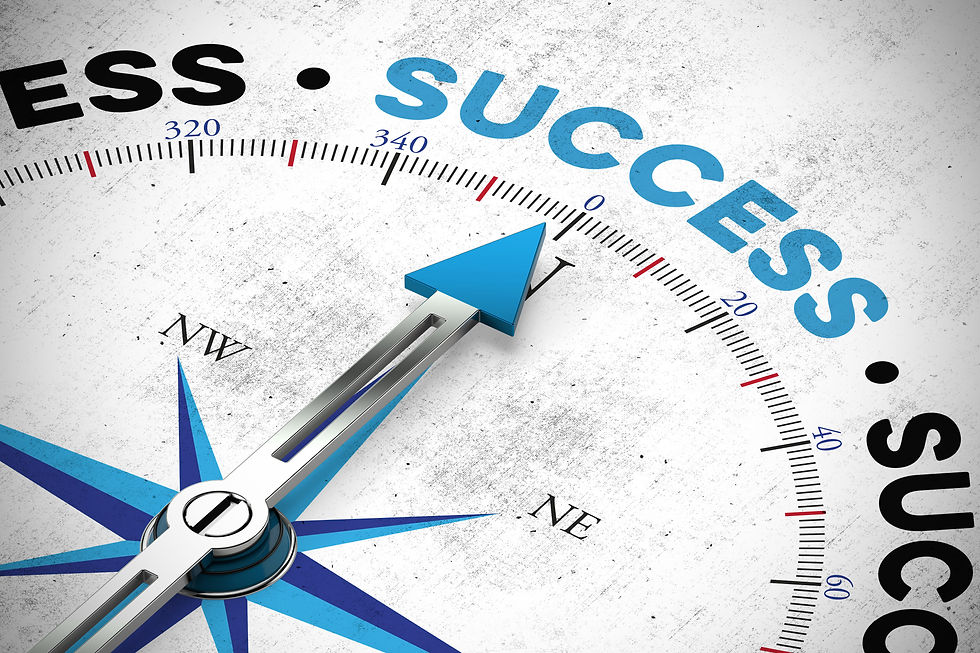Utilizing a 5-Year Business Plan a Roadmap for Success
- Jeff Mayfield

- Jan 3
- 5 min read
Updated: Mar 14
A well-crafted 5-year business plan is more than just a document; it’s a roadmap guiding your business toward sustainable success. It outlines your goals, strategies, and the steps needed to achieve them while preparing you for challenges along the way. In this article, we will explore how to effectively utilize a 5-year business plan, breaking it down into actionable insights that empower you to stay on track and achieve your long-term vision.

Over the years of my professional career, I have witnessed firsthand the transformative power of strategic planning and long-term business forecasting. Beginning in public accounting, progressing through 18.5 years as a Chief Financial Officer, and culminating in my role as President and CEO of a manufacturing company in the metal fabrication industry, I’ve had the privilege of developing and implementing complex 5- to 10-year business plans. These experiences have solidified my belief that strategic planning and forward-thinking are not just tools—they are the foundation for sustained success in any organization, regardless of industry.
In this article, I aim to share insights into the critical importance of strategic planning and creating a 5-year business plan. Drawing on my own experiences, I’ll illustrate how these frameworks can guide an organization toward achieving its goals, adapting to challenges, and fostering innovation. Whether you're navigating growth, overcoming obstacles, or seeking to maintain a competitive edge, these planning tools provide clarity and direction that are essential for long-term success.
Join me as we explore the building blocks of effective strategic planning and how you can leverage these principles to elevate your organization’s performance and future.
Introduction: The Importance of a 5-Year Business Plan
A 5-year business plan serves as the cornerstone of strategic planning. It aligns stakeholders, clarifies objectives, and establishes metrics for success. Unlike short-term plans, which focus on immediate tasks, a 5-year plan provides a big-picture view, enabling you to anticipate market trends, allocate resources effectively, and manage risks.
The key to leveraging a 5-year business plan lies in understanding how to use it as a dynamic tool rather than a static document. Below, we’ll outline the essential components of a 5-year plan, its benefits, and how to implement it effectively.
Components of a 5-Year Business Plan
Executive Summary
A concise overview of your business, mission, and vision. Note: See my articles on mission and vision.
Key highlights of your goals and strategies and comprehensive analysis of Strengths, Weaknesses, Opportunities, and Threats,

Market Analysis
Detailed research on your industry, competitors, and target audience.
Identification of market trends and opportunities.
Business Objectives
Clear, measurable goals for the next five years.
Objectives should follow the SMART criteria (Specific, Measurable, Achievable, Relevant, Time-bound).
Strategic Initiatives
Key projects, programs, and initiatives to achieve your objectives.
Outline of timelines and resource allocation.

Financial Plan
Revenue projections, expense forecasts, and profit margins.
Funding requirements and investment strategies.
Operational Plan
Details on day-to-day operations, staffing, and process management.
Workflow efficiencies and scalability considerations.
Risk Assessment
Identification of potential risks and mitigation strategies.
Contingency plans for market changes or unforeseen challenges.
Step-by-Step Approach to Utilizing Your 5-Year Business Plan
1. Align Your Team with the Vision
Communicate the Plan: Share the business plan with your team to ensure everyone understands the vision and goals.
Assign Roles and Responsibilities: Break down objectives into departmental or individual tasks, creating accountability.
2. Set Short-Term Milestones
Divide the 5-year plan into annual or quarterly goals to make progress measurable.
Monitor milestones regularly to stay aligned with the overarching strategy.
3. Track Key Performance Indicators (KPIs)
Define KPIs that align with your objectives (e.g., revenue growth, customer acquisition, or employee satisfaction).
Use data analytics tools to monitor progress and make data-driven decisions.
4. Allocate Resources Wisely
Ensure that financial, human, and technological resources align with your strategic initiatives.
Regularly review and adjust resource allocation based on performance metrics.
5. Review and Adjust the Plan
Schedule regular reviews (e.g., quarterly or annually) to evaluate the plan’s relevance and effectiveness.
Be prepared to adapt to market changes, new opportunities, or unforeseen challenges.
6. Foster a Culture of Continuous Improvement
Encourage feedback from team members to refine strategies and processes.
Promote innovation to stay competitive and agile.
Benefits of Utilizing a 5-Year Business Plan

1. Clarity and Focus
A detailed plan eliminates ambiguity and aligns efforts toward common goals.
Teams work more cohesively when they understand the big picture.
2. Better Decision-Making
Strategic planning provides a framework for evaluating decisions against long-term objectives.
Reduces impulsive or reactionary choices that could derail progress.
3. Enhanced Resource Management
Forecasting helps allocate resources efficiently, reducing waste and maximizing ROI.
Anticipates future needs, ensuring preparedness for growth.
4. Risk Mitigation
Identifies potential threats early, allowing for proactive responses.
Contingency plans minimize disruptions during crises.
5. Increased Investor Confidence
A robust 5-year plan demonstrates professionalism and foresight, attracting potential investors or stakeholders.
Transparency in financial projections builds trust.
Real-Life Examples of Businesses Leveraging 5-Year Plans
1. Starbucks
In the late 2000s, Starbucks implemented a 5-year plan focusing on international expansion and product diversification.
By aligning teams with clear goals and continuously monitoring performance, Starbucks successfully increased market share and profitability.
2. Amazon
Amazon’s 5-year planning in logistics and cloud computing laid the foundation for Amazon Web Services (AWS), now a significant revenue stream.
Their commitment to innovation and adaptability has kept them ahead of competitors.
3. Tesla
Tesla's 5-year plans emphasize sustainability, technological innovation, and scaling production.
By adhering to their roadmap, Tesla has become a leader in the electric vehicle market.
Common Challenges and How to Overcome Them

1. Lack of Flexibility
Challenge: Rigid adherence to the plan can hinder adaptability.
Solution: Build flexibility into your plan by incorporating periodic reviews and allowing for adjustments.
2. Insufficient Buy-In
Challenge: Teams may resist changes or fail to see the plan’s value.
Solution: Involve employees in the planning process to create a sense of ownership and commitment.
3. Inaccurate Projections
Challenge: Overestimating or underestimating resources or market conditions can derail progress.
Solution: Use data-driven methods and seek expert insights to create realistic projections.
4. Poor Communication
Challenge: Miscommunication can lead to misunderstandings and misaligned efforts.
Solution: Establish clear communication channels and regularly update all stakeholders.
Practical Tips for Maximizing the Impact of Your 5-Year Plan
1. Leverage Technology

Use project management tools (e.g., Trello, Asana, or Microsoft Planner) to track progress.
Employ financial software for budgeting and forecasting.
2. Engage in Continuous Learning
Stay informed about industry trends and emerging technologies.
Encourage team members to participate in training programs and professional development.
3. Build Strategic Partnerships
Collaborate with other businesses, organizations, or thought leaders to enhance your capabilities.
Partnerships can open new markets and drive innovation.
4. Celebrate Milestones
Recognize and reward achievements to keep teams motivated.
Celebrations reinforce commitment and enthusiasm for the long-term vision.
Developing an Implementation Plan for Your 5-Year Business Plan
Step 1: Define Clear Objectives
Break down the plan into smaller, actionable steps for each department or team.
Step 2: Create a Timeline
Develop a Gantt chart or project schedule to visualize timelines and dependencies.
Step 3: Assign Responsibility
Designate leaders or managers to oversee specific objectives and initiatives.
Step 4: Monitor Progress
Set regular check-ins to discuss progress and address challenges.
Step 5: Adjust as Needed
Be proactive in revising strategies based on feedback and performance metrics.
Conclusion: Turning Vision into Reality
A 5-year business plan is more than a tool for planning; it’s a framework for execution, growth, and resilience. By aligning your team, setting measurable goals, and remaining adaptable, you can transform your vision into a thriving reality.
Success with a 5-year plan depends on treating it as a living document—one that evolves with your business and the market. Through continuous improvement, resource optimization, and effective communication, your business can navigate challenges and seize opportunities, setting the stage for long-term success.
By leveraging the strategies outlined in this article, you can ensure your 5-year plan becomes the cornerstone of your business’s achievements, driving growth and sustainability for years to come.



